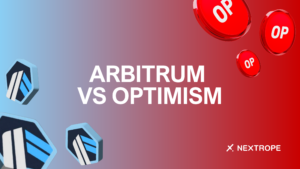In the extensive and continuously growing realm of blockchain and cryptocurrency, the search for scalable Ethereum solutions has become a crucial battlefront. As Ethereum shifts towards proof-of-stake, layer-2 scaling solution contenders like Arbitrum and Optimism have gained prominence. The launch of the ARB token has further fueled the competition, enticing crypto aficionados and professionals to examine and assess these two platforms' technical capabilities. While they vie for the esteemed title of 'King of Ethereum Scaling,' it leads to the question: Is there a clear frontrunner between them? This article aims to shed light on this urgent query by exploring the structure, ecosystems, and potential trajectories of both Arbitrum and Optimism.
READ ALSO: Arbitrum vs Polygon
Arbitrum vs Optimism: Architectural Differences

As Ethereum strives for enhanced scalability, layer-2 chains such as Arbitrum and Optimism have emerged as prominent solutions. Utilizing "optimistic rollups," these chains offer an innovative approach by condensing several transactions into one, effectively moving traffic away from the congested Ethereum mainnet to a swifter, more efficient second layer. This brilliant technique significantly reduces the burden on the primary layer, leading to faster transactions and more affordable fees.
Optimistic rollups rely on a trust-based principle, optimistically presuming that collected transaction data in batches are valid when verified on the main Ethereum chain. "Fraud proofs" provide a strong safety measure, inspecting and confirming data legitimacy. This trustless system enables instant transaction finality and substantial throughput improvements compared to traditional Ethereum setups. However, there is a compromise – a seven-day challenge window exists to question transaction validity. Furthermore, these systems utilize a 'sequencer' to order transactions prior to their integration into the main chain.
Despite appearing similar at first glance, Arbitrum and Optimism possess subtle architectural distinctions. Fundamentally, Optimism implements single-round fraud proofs for expediency but incurs higher gas fees due to transactions occurring on the core Ethereum layer. Conversely, Arbitrum adopts a more economical method using multi-round fraud proofs, which take longer but are less expensive.
Distinct choices in virtual machines are another differentiating factor. While Optimism solely relies on the Ethereum Virtual Machine (EVM) and confines its programming paradigm to Solidity, Arbitrum expands its possibilities with the custom Arbitrum Virtual Machine (AVM), supporting all EVM-compatible languages for increased adaptability.
Ultimately, these minor technical variations between Arbitrum and Optimism can result in significantly different user experiences as each platform addresses specific needs and preferences.
Arbitrum vs Optimism: Analyzing the Ecosystem

A thorough analysis of both Arbitrum's and Optimism's ecosystems in the struggle for supremacy among Layer-2 scaling solutions reveals intriguing findings. Both platforms are built on optimistic rollups, and their growth metrics tell a fascinating tale.
A distinct lead is evident for Arbitrum when looking at the Total Value Locked (TVL). Data indicates that Arbitrum's TVL surpasses Optimism's by over twice as much, representing a substantial difference in the DeFi realm. Delving into the distribution of TVL, this difference becomes even more marked. Derivatives and decentralized exchanges (Dexes) contribute significantly to Arbitrum's diversified portfolio, whereas Dexes account for a considerable proportion of Optimism's TVL.
Exploring native versus non-native protocols further highlights the dominance of Arbitrum. A large portion of its TVL comes from native protocols, while Optimism falls behind in this regard. It is essential to recognize GMX's substantial impact on Arbitrum, contributing significantly to its TVL.
Arbitrum maintains its superior position from an activity perspective, boasting higher protocol numbers, increased daily active addresses, and improved transaction rates. The recent airdrop amplified their dominance; however, it remains critical to observe whether these metrics will stabilize or change after the initial excitement surrounding the airdrop.
Arbitrum vs Optimism: Upcoming Catalysts

Even though current information seems to favor Arbitrum, both platforms' future plans present exciting prospects capable of reshaping the L2 space.
Optimism spearheads an innovative project with OP Stack: an ambitious plan aiming to create a scalable, modular, and interoperable blockchain system. Their forthcoming product, Optimism Bedrock, is expected to incorporate modularity and usher in improved performance statistics. Their collaboration with Coinbase could be their most significant advantage in forming a "Superchain": a seamless network built on top of the OP Stack to enhance inter-chain connectivity and functions.
Arbitrum, on the other hand, does not intend to rest on its achievements. The introduction of the ARB token drop not only supports greater decentralization but also aims to entice a larger user base. Other noteworthy initiatives include Arbitrum Nova, which intends to lower gas fees dramatically, favoring applications requiring high bandwidth. Their prioritization shifts to developer access, with projects like Arbitrum Orbit and the Stylus upgrade meant to draw in a wider developer audience.
To understand this topic better, we recommend you watching this video:
Conclusion
Which platform emerges as the victor in this struggle of optimistic rollup titans?
Arbitrum currently claims the crown, with its remarkable TVL, heightened user engagement, and notable transaction volume amplified by the ARB airdrop. Nonetheless, the dynamic nature of the crypto world is notorious for swift changes and surprising turns – and with a promising roadmap and partnership with Coinbase, Optimism might well become a powerful competitor.
Both L2 platforms offer immense potential as they continue to develop, further shaping the story of this captivating rivalry.
READ ALSO: 'Arbitrum to Polygon Bridge'
 en
en  pl
pl 












